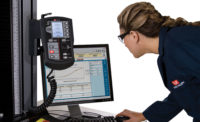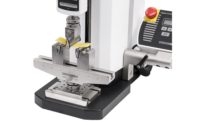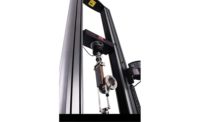Retrofits: Ensuring the Reliability and Capability of Your Universal Testing System
When considering legacy equipment in your lab it is important to recognize what makes a good candidate for a retrofit.

This is a retrofit Instron 5500 Series floor model.
Whether you work in a quality control laboratory at a major automotive manufacturer or are performing research at a university, it is common to encounter a universal testing machine that was manufactured before the 21st century. A robust testing system, whether hydraulically or electromechanically actuated, can perform effectively for upwards of 30 years when maintained with proper preventative care. As time passes, however, aging system components eventually increase the risk of system downtime. This downtime causes frustration, endangers product shipments, and can lead to the need for outsourced testing. For those using an older mechanical testing system, it is important to understand what options are available to help mitigate these risks and keep testing on schedule.
Understanding the importance of your testing system
Manufacturers of universal testing machines can often help determine the risk of downtime associated with a particular system, but only you as the user can fully understand how critical a piece of equipment is to your individual operation. The best way to assess the criticality of a system is to ask yourself, “If this machine went down today, for two weeks, what impact would this have on our business?” In some environments, the impact may be none! If a system is currently unused, or if a backup with bandwidth is readily available, a machine’s criticality may be fairly low. On the other hand, if testing on a system is required in order to release batches of material to downstream customers, this means that the machine is a vital link in the production chain, and downtime could have severe financial consequences.
Understanding the lifecycle of your testing system
Many universal testing machine manufacturers use a product life cycle system in order to classify current and legacy products. These life cycles can help provide clarity when it comes to assessing the risks associated with the different components of a testing system. While out-of-production equipment in earlier life cycle phases is typically fully supported, later life cycle phases indicate that the equipment is getting older and that replacement parts are becoming difficult to source. At best, this means the possibility of longer downtime in the event of malfunction. At worst, it means an inability to repair the product. Ask your universal testing machine provider or service provider if they can help perform a life cycle and risk assessment for your laboratory systems.
Instead of replacing an entire test system, many users opt to perform a system retrofit instead. Retrofits allow for the replacement of at-risk components as well as components nearing the end of support. By replacing these components, the effective life cycle phase of the entire system can be improved, ensuring the longevity and serviceability of your investment.

Risk Assessment Matrix – Life Cycle Phase vs. Criticality of Machine
The value of a retrofit - Reliability
The main values of a system retrofit can be broken down into two sections: reliability and capability. Understanding the criticality of your testing system and its current place in the product life cycle are the first steps to understanding your risk level. More than anything, retrofitting an older system can drastically reduce the risk of unexpected downtime and therefore the need to outsource testing.
Outsourcing your testing can lead to your organization incurring some or all of the following costs:
- Setup fees (per batch)
- Testing fees (per sample)
- Additional fees for elevated temperature testing
- Shipping costs
- Expediting fees (upwards of 100% for 24hr turnaround)
- Cost of delays and missed product shipment
In addition to simple costs, outsourcing your testing also poses risks such as:
- Differing test setups
- Operator unfamiliarity with specific methods or tests
- Disruptive data records and reporting schemes
- Elevated risk of data inaccuracy
Some manufacturers can proactively retrofit a system while it remains on site, allowing you to plan for minimal downtime instead of being caught by surprise. The ability to schedule the replacement of at-risk components allows you to remain in control of your schedule, costs, and investment.
The value of a retrofit – Capability
The value of a retrofit can be much greater than just improvement to the reliability of your testing system. As materials testing technology improves, the software used to run universal testing machines has become simpler, more secure, and more powerful. Software compatibility typically depends on the control electronics on a system and the operating system of the computer, while depending much less on hardware such as ball screws and pieces of metal. Even systems manufactured 20 to 30 years ago may be capable of running the latest and most powerful software on the market once a retrofit has been performed. Having the latest software on all systems in a laboratory reduces the need for operator specialization and training, ensures full software support, and keeps test methods cohesive and sustainable.
Testing consistency, data accuracy, and efficiency are some of the most important concepts in the materials testing industry, and many of the industry’s latest testing accessories are designed to improve performance in these areas. Manual placement of the extensometer accounts for the largest source of error in strain measurement. Automatic extensometry allows for strain measurement with reduced operator interaction. These extensometers, both contacting and non-contacting, can greatly improve the repeatability of strain measurements but often require the latest control electronics in order to function. A retrofit can allow an older frame to become compatible with these devices in addition to other advanced accessories.

Retrofit electromechanical and static hydraulic systems: (A) Updated control electronics; (B) update to the latest software (C) example updates: power supply, safety components, circuit boards, transducers, hydraulic pump, etc.
Retrofit vs. Replace
When considering legacy equipment in your laboratory it is important to recognize what makes a good candidate for a retrofit. Systems should be fully operational before being retrofit as a retrofit alone does not address broken mechanical components. Once a frame is restored to working condition, a manufacturer will help you understand what retrofit options are available. It is important to keep a system well maintained throughout its lifetime in order to ensure that all upgrade paths are available.
Besides the condition of the frame, it is important to consider the cost associated with retrofitting or replacing a system. A retrofit allows retention of the main mechanical assembly as well as the existing mechanical accessories, some of which may be particular to the mechanics of a system. Higher capacity testing systems have proportionally larger costs associated with the mechanical components of the frame as opposed to the electronics, making a full system replacement significantly more costly than a retrofit. As frames decrease in size, the cost of a retrofit tends to approach the cost of a new system. In choosing between a retrofit and a replacement, is important to evaluate not only the cost of the new system but also the potential costs of moving the old system, ensuring accessory compatibility, and modifying work instructions to remain relevant to a new system. Q
Looking for a reprint of this article?
From high-res PDFs to custom plaques, order your copy today!





